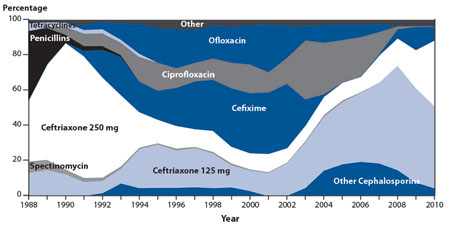 James Hamblin, MD, at The Atlantic, here, writes,
James Hamblin, MD, at The Atlantic, here, writes,
The list of effective antibiotics has been dwindling as the bacteria became resistant, and now it’s down to one. Five years ago, the CDC said fluoroquinolones were no longer effective, but oral cephalosporins were still a common/easy treatment. Now injected ceftriaxone is the only recommended effective drug we have left. And it has to be given along with either azithromycin or doxycycline.
Dr. Hamblin and The Atlantic also reproduced the graphic, above, tracing the treatments in use from 1988 to 2010. Penicillins stopped being effective in the early 1990’s. While this news is disturbing, it also illustrates how evolution works. A small percentage survive because of natural resistance. They reproduce. Their offspring have the resistant genes. Whether it’s grey moths that are obvious on trees in pristine environments and difficult to see on trees where the smog coloured the bark, pests in a farm field, or infectious bacteria, the principle is the same.
Looking from a whole systems perspective, maybe we need to develop medications that stimulate the human immune response, rather than medications that try to kill the bacteria.
Cord Jefferson, writing at Gawker, here, reports
Gonorrhea, an STD that can cause infertility and death, is … closer to untreatable than it has been since doctors devised a way to treat it in the first place. We’re down to just one antibiotic that can effectively fight the disease.
Gonorrhea is a major cause of serious reproductive complications in women and can facilitate human immunodeficiency virus (HIV) transmission. Effective treatment is a cornerstone of U.S. gonorrhea control efforts, but treatment of gonorrhea has been complicated by the ability of Neisseria gonorrhoeae to develop antimicrobial resistance.
National Institute of Health. “Gonorrhea is caused by the bacteria Neisseria gonorrhoeae. Anyone who has any type of sex can catch gonorrhea. The infection can be spread by contact with the mouth, vagina, penis, or anus.”
CDC,
New Treatment Guidelines for Gonorrhea: Antibiotic Change
– CDC expert commentary featuring Dr. Robert Kirkcaldy (August 13, 2012)
Update to CDC’s 2010 Sexually Transmitted Disease Treatment Guidelines: Oral Cephalosporins No Longer Recommended Treatment for Gonococcal Infections – MMWR August 10, 2012 (August 9, 2012)
> Audio Podcast – Dr. Robert Kirkcaldy, lead author, discusses updates to CDC’s gonorrhea treatment guidelines in this three minute audio podcast.
> Press Release – Media announcement about updated gonorrhea treatment guidelines, includes quotes from NCHHSTP leadership
> Media fact sheet– Details changes to updated gonorrhea treatment, gonorrhea trends, and call to action
Cephalosporin-Resistant Neisseria gonorrhoeae Public Health Response Plan
(August 9, 2012)
Updated Gonorrhea Clinical Training: (August 9, 2012)
> Self-Study Module for Clinicians
> Ready-to-use Module for Clinical Educators
Medical Look “Gonorrhea is actually one of the most common sexually transmitted disease in the U.S. and is growing in rate of diagnosis annually. Once thought of as a sexually transmitted disease of the past, gonorrhea has become one of the largest health threats to sexually active individuals. Despite popular opinion, gonorrhea is not limited to the homosexual and bi-sexual communities but is an equal opportunity social disease.”